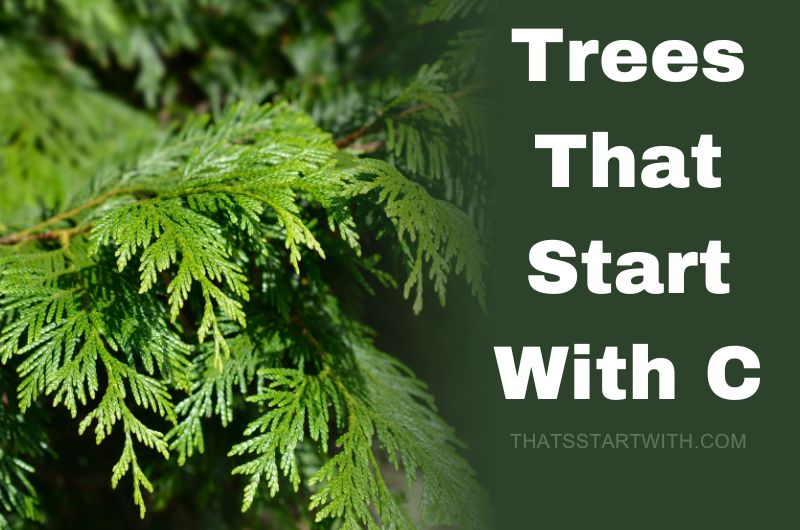
Trees, with their towering presence and invaluable ecological significance, grace our planet with their diverse forms and functions.
Among them, those whose names that with the letter C hold a special charm. From the majestic Cedar to the humble Crabapple, each species adds its unique touch to the tapestry of nature.
Join us on a journey through remarkable trees, each beginning with the letter C, showcasing the rich biodiversity our world has to offer.
Trees That Start With C
Cedar:
Cedars stand tall with their aromatic wood and striking foliage. These evergreen conifers symbolize strength and resilience, gracing landscapes across the globe.
Cypress:
Known for their slender, elegant forms and distinctive cones, cypresses populate various habitats, from swamps to mountainsides, offering beauty and ecological value.
Cherry:
Cherries, with their delicate blossoms and succulent fruits, captivate both humans and wildlife alike. They symbolize spring’s arrival and the promise of renewal.
Chestnut:
Once abundant in forests, chestnuts provided sustenance for humans and animals alike. Though diminished by disease, efforts to revive these majestic trees continue.
Catalpa:
With their large heart-shaped leaves and showy flowers, catalpas add a touch of tropical flair to temperate landscapes, attracting pollinators with their nectar-rich blooms.
Crabapple:
Crabapples, with their petite fruits and ornamental blossoms, decorate gardens and orchards, serving as focal points of beauty and biodiversity.
Cottonwood:
Towering along riverbanks and floodplains, cottonwoods provide shade and stability, their fluffy seeds signaling the arrival of summer breezes.
Cacao:
Originating from tropical regions, cacao trees gift us with the beans from which chocolate is derived, embodying the delights of indulgence and cultural significance.
Cabbage Palm:
Adorning coastal landscapes, cabbage palms withstand harsh winds and salt spray, their iconic silhouettes evoking a sense of resilience and endurance.
Canary Island Date Palm:
With its stout trunk and graceful fronds, the Canary Island Date Palm lends a touch of the exotic to Mediterranean climates, symbolizing warmth and hospitality.
Carob:
A symbol of sustenance and tradition, carob trees yield pods rich in nutrients, offering a chocolate alternative and a connection to ancient agricultural practices.
Cedar of Lebanong:
Steeped in history and mythology, the Cedar of Lebanon stands as a national emblem, its enduring presence reflecting strength and cultural heritage.
Chaste Tree:
Celebrated for its aromatic foliage and clusters of violet blooms, the chaste tree embodies purity and healing, attracting bees and butterflies to its nectar.
Chinaberry:
Despite its invasive tendencies, the chinaberry tree boasts fragrant flowers and vibrant fruits, entwined with folklore and medicinal uses in various cultures.
Chinese Elm:
Resilient and adaptable, Chinese elms thrive in urban settings, providing shade and shelter while showcasing their unique exfoliating bark and graceful forms.
Cinnamon Tree:
The source of a beloved spice, cinnamon trees offer more than culinary delights, with their aromatic bark and glossy leaves contributing to traditional medicine and perfumery.
Cork Oak:
Harvested for centuries for its renewable bark, cork oaks exemplify sustainable forestry practices, supporting biodiversity in Mediterranean ecosystems.
Crabwood:
Native to tropical rainforests, crabwood trees yield valuable timber and medicinal compounds, underscoring the importance of conserving biodiversity in threatened habitats.
Crepe Myrtle:
Admired for their profusion of colorful blooms and peeling bark, crepe myrtles brighten landscapes and signify the beauty of summer.
Crimson Bottlebrush:
Native to Australia, crimson bottlebrush trees dazzle with their vibrant red flowers, attracting birds and pollinators to gardens and natural habitats.
Corkscrew Willow:
Eccentric in form and versatile in function, corkscrew willows add whimsy to water features and landscapes, their contorted branches capturing attention year-round.
Chinese Fringe Tree:
Graced with delicate, fringe-like flowers in spring, Chinese fringe trees evoke a sense of ethereal beauty, enriching gardens with their elegant presence.
Coast Redwood:
Among the tallest trees on Earth, coast redwoods inspire awe with their towering stature and ancient lineage, embodying the resilience of natural ecosystems.
Coral Tree:
Named for their vibrant red flowers, coral trees lend tropical flair to landscapes while supporting diverse wildlife with their nectar-rich blooms.
Crape Myrtle:
Celebrated for their profusion of colorful blooms and ornamental bark, crape myrtles symbolize the vibrancy of summer and the joys of gardening.
Cucumber Tree:
Native to eastern North America, cucumber trees showcase large, fragrant flowers and cucumber-shaped fruits, attracting pollinators and wildlife to forest ecosystems.
Cycad:
Ancient and enduring, cycads offer living connections to prehistoric times, their unique forms and adaptations captivating enthusiasts and researchers alike.
California Bay Laurel:
Resilient and aromatic, California bay laurels thrive in diverse habitats, their foliage and fruits supporting wildlife and culinary traditions.
California Sycamore:
Found along watercourses and in riparian zones, California sycamores provide shade and habitat, their mottled bark and large leaves adding character to landscapes.
Canary Island Pine:
Native to the Canary Islands, these pines dominate volcanic slopes with their stout trunks and distinctive crowns, symbolizing resilience and adaptation.
Chinese Pistache:
Valued for their vibrant fall foliage and drought tolerance, Chinese pistache trees enhance urban landscapes and provide shade in challenging environments.
Cockspur Coral Tree:
Named for its spiny branches and vibrant flowers, the cockspur coral tree adds drama and color to tropical and subtropical landscapes, attracting pollinators and admiration.
Canadian Hemlock:
Thriving in cool, moist forests, Canadian hemlocks offer shelter and sustenance to wildlife, their graceful boughs and evergreen foliage epitomizing forest serenity.
Chinese Scholar Tree:
Admired for its ornamental value and cultural significance, the Chinese scholar tree graces parks and gardens with its elegant form and fragrant flowers.
Cinnamon Teal Tree:
From its aromatic bark to its flavorful spice, the cinnamon teal tree enchants with its sensory delights, contributing to culinary and wellness traditions worldwide.
Coffee:
Originating from tropical regions, coffee trees yield the beloved beans that fuel our mornings and social gatherings, embodying global interconnectedness and ritual.
Corkscrew Hazel:
A whimsical addition to gardens, corkscrew hazels captivate with their contorted branches and unique charm, adding texture and intrigue to winter landscapes.
Cotton Silk Tree:
Known for its large, showy flowers and spiny trunk, the cotton silk tree symbolizes resilience and vitality, gracing tropical landscapes with its seasonal blooms.
Camphor Tree:
With its aromatic foliage and medicinal properties, the camphor tree has cultural significance and ecological value, supporting biodiversity in its native habitats.
Cape Chestnut:
Native to South Africa, the cape chestnut showcases fragrant flowers and attractive foliage, contributing to the beauty and biodiversity of subtropical regions.
Chinese Juniper:
Adapted to diverse climates, Chinese junipers exhibit varied forms and foliage, their berries providing sustenance for wildlife and traditional medicine for humans.
Chinese Scholar Tree:
Admired for its ornamental value and cultural significance, the Chinese scholar tree graces parks and gardens with its elegant form and fragrant flowers.
Coral Gum:
Native to Western Australia, coral gums enchant with their profusion of pink flowers and smooth bark, adding color and fragrance to arid landscapes.
Crab’s Eye:
Despite its toxic seeds, crab’s eye trees possess cultural significance and ecological importance, showcasing unique adaptations and connections to local ecosystems.
Creeping Willow:
Thriving in wetland habitats, creeping willows provide erosion control and habitat for wildlife, their trailing branches and slender leaves adding grace to water’s edge.
Cuckoo-pint:
Found in woodlands and meadows, cuckoo-pint trees feature striking foliage and berries, their presence adding intrigue and biodiversity to understory habitats.
Currant:
From blackcurrants to red and white varieties, currant trees offer flavorful berries and ornamental value, supporting pollinators and human enjoyment in gardens.
Cape Willow:
Adapted to riparian zones and wetland habitats, cape willows provide erosion control and habitat for wildlife, their slender branches and lance-shaped leaves adding grace to waterways.
Claret Ash:
Valued for its vibrant autumn foliage and adaptable nature, the claret ash enhances landscapes with its seasonal color and architectural form.
Cockspur Thorn:
With its thorny branches and glossy foliage, the cockspur thorn adds security and ornamental value to gardens and natural landscapes, showcasing resilience and adaptation.
Coral Bark Maple:
Renowned for its striking winter bark and delicate foliage, the coral bark maple adds year-round interest to gardens and urban settings, symbolizing resilience and beauty.
Cucumber Magnolia:
Native to eastern North America, cucumber magnolias adorn forests with their fragrant flowers and cucumber-shaped fruits, providing sustenance for wildlife and delight for observers.
Related Articles:
Conclusion:
From towering conifers to delicate flowering specimens, the realm of Trees That Start With C encompasses a diverse array of species, each with its own story to tell and ecological role to play.
As stewards of our planet, let us cherish and protect these arboreal treasures, ensuring their presence for generations to come.

Greetings, I’m Asad Hamid, the author behind this blog. I possess a keen interest in exploring a variety of topics spanning from A to Z through my reading endeavors.